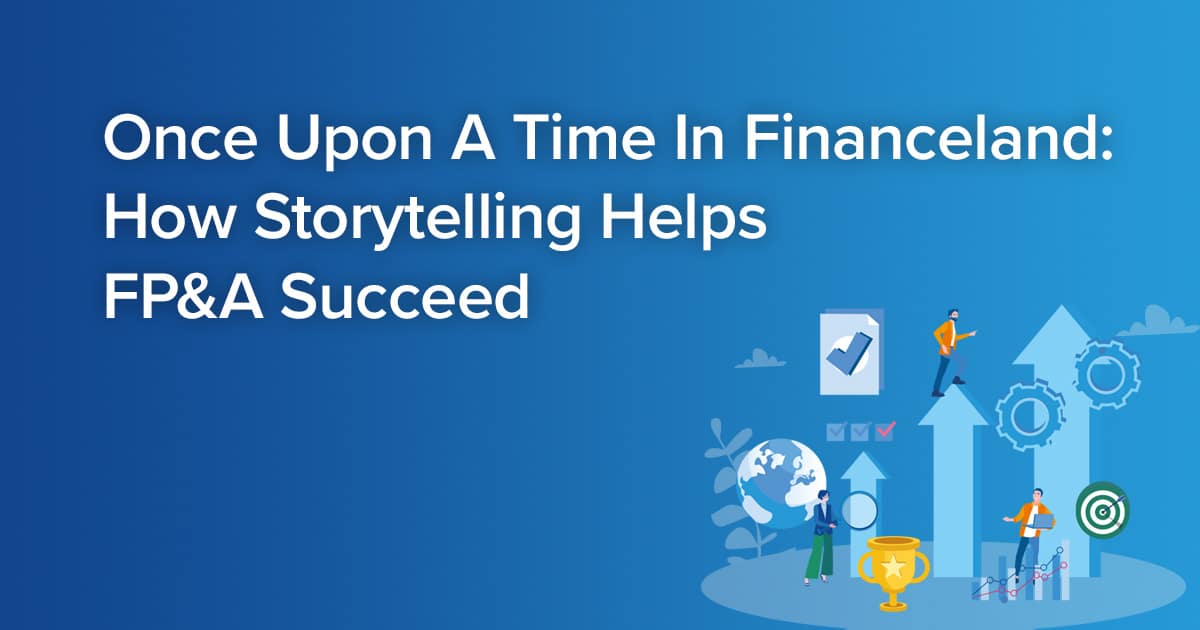
Once Upon a Time in Financeland: How Storytelling Helps FP&A Succeed
This week, Mohamed ElRouby and Anders Liu-Lindberg carry you away into Financeland, where they make a case for storytelling in Finance, and how it helps in succeeding as a business partner for all stakeholders.
Stories. They’re what bind all of us together because everyone likes and can understand a good story. When we were kids and our parents had to calm us down after a long day or when going to bed, they would read us stories. Imagine replacing “stories” with “numbers” in these lines. Does it make sense? No, right? While everyone understands good stories only some of us understand numbers, so they can never be the common denominator which we use to communicate to our audience. Hence, rather than leading with numbers FP&A must lead with stories to be heard.
Not everyone can tell a good story
The problem is, of course, that not everyone can tell a good story. Just like being good with numbers is a skill so is telling a good story. In fact, telling the story is a skill as well as is coming up with the story. That’s typically not something FP&A professionals are good at which means their effectiveness of communicating their insights generated from the analysis will suffer. So, what can FP&A do to become better storytellers?
- Understand what lies behind the numbers because that will provide a context which you need to create the story.
- Communicate with anything but numbers and instead use words or, even better, visuals because non-finance people easily get lost in all your tables.
- Go and experience the business so that you understand the reality that your stakeholders operate in.
- Become a better presenter because to tell a good story you must move beyond the content and act your way through the story. That you cannot do if all you’re thinking about is how to make sure you cover all the content.
One thing is knowing how to it but another is to execute when standing “on stage”. That’s why learning from practitioners who’ve done it and succeeded is critical for others to succeed too!
A story of storytelling from an FP&A practitioner
To share one such example I’ve invited Mohamed ElRouby to share some examples of how he has used storytelling to communicate his insights about business performance to his stakeholders. Mohamed, the stage is all yours!
Story one
When I was the FP&A Manager at Energizer Egypt, the global batteries and household products market leader, I had to present to the regional team the 12 months latest estimate which included 4 months actuals and 8 months forecast. The regional team at that time was expecting significant upside from our country because the first 4 months actuals were significantly higher than the average run rate on sales performance. If I presented the numbers as is without a strong business story, the regional management will ask my country to deliver more upside and would even increase our target. So, I was in a situation that I had to explain why the first 4 months are significantly higher and why the rest of the year should come back to the average run rate.
Because I already spent quality time with business people, distributors, wholesales, supply chain, and sales reps I was able to understand the business rationale of the higher 4 months.
The story was the first 4 months in the year are the winter season in Egypt and the batteries are essential for the gas heaters devices to switch them on. Hence, the consumer purchases usually increased significantly in the winter season and the demand will come back to the normal trend in the rest of the year.
When I presented that business story with proper presentation, I could give confidence that my forecast is accurate and the sales trend in the rest of the year made sense.
Key learning: Move away from your desk and spend quality time with your business partners.
Story two
When I was doing a regional FP&A role in a global pharmaceutical company, one country under my responsibility was showing a significant decrease in the gross margin. At that time, I had to present to the area leadership team the P&L for that country and I had to explain to them why the profitability had decreased.
To do that I made a deep dive cost analysis to understand the main reasons behind that change. I found one cost element, stickering and packaging, that was driving the increase in the cost of sales. When I dug further in my analysis, I found the significant cost increase in stickering.
I started to speak to the business and finally, I got the answer from a function which I usually did not spend much time with before. It was the regulatory affairs department. They told me there were new regulations in the country by the ministry of health to add a sticker on each pack with additional information about the product and serialization. Those stickers added an additional job at the manufacturing site which was the main reason for the increase in the cost of sales and accordingly the profitability of the country had declined.
When I presented that story with clear business rationale and with proper supporting slides and references, it was highly appreciated by the area and they understood that decrease in the profitability is not related to performance, pricing or product mix. No change in the strategy was needed. It was all about new external regulations.
Key learning: Dig more and more, ask why, why, why, until you got the right story, speak to all functions and not only commercial, as you might find the answer from an unexpected source.
Two great stories from Mohamed which could’ve easily gone the usual way of FP&A simply presenting the variance analysis and asking the business to explain what’s happening. This would’ve led to a myriad of new requests and only maybe would the right answer have been found!
From stories to action
As FP&A professionals we must go further to learn the real reasons behind business performance and tell the right story to our business leaders. That’s when you can start to discuss what to do about things. In the stories from Mohamed, at least a few actions would stand out to me.
Story 1
- Increase the market understanding of the Egyptian market
- Run more campaigns during Summer where batteries don’t sell as easily
- Target new segments with your products to increase Summer sales
Story 2
- Try to better understand the changed manufacturing process and learn if anything can be optimized in performing the new job
- See if the cost increase can be passed on to customers citing external regulations
- Lobby with policy-makers to understand if the information on the new sticker can rather be included on the current sticker(s) or even be completely removed again
These are just some ideas and likely through simple brainstorming a lot more ideas could be brought to the table. Remember, your work doesn’t stop when you’ve told the story. You must progress to what actions to take and follow up on if the actions delivered the desired results. Otherwise, FP&A can never deliver on its purpose to drive the right strategic choices in the company.
What stories are you telling? Are they similar to Mohamed’s or are they stories of pure numbers which your stakeholders find it hard to relate to? It’s through stories that we create the connections and forge the relationships with our business stakeholders that we so desperately need to be successful!


